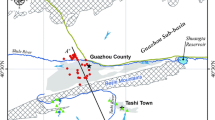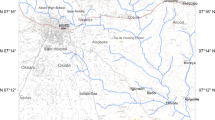Abstract
Karst subterranean streams are important water resources and life-support systems in karst areas and hydrogeochemistry research is an indispensable tool for karst aquifer protection. There are approximately 380 known subterranean streams in the Chongqing area, which are a fundamental groundwater resource. Hydrogeochemical analysis of 84 karst subterranean streams in Chongqing indicated that the solutes mainly came from the dissolution of carbonate rock (using the Gibbs diagram) and most subterranean streams are influenced by the anthropogenic processes. Also, the hydrochemical characteristics showed clear regional effects in natural background chemistry and human impacts. The calcite content decreases and the dolomite content increase from Triassic to Cambrian carbonate rock (except in the Permian carbonate rock), so that subterranean streams that developed in the Cambrian carbonate rock have the highest Mg2+ concentration. Karst subterranean streams that developed in the Permian strata displayed the lowest Mg2+ concentration due to the lowest dolomite concentration in Permian strata. Under the same geological settings, major hydrochemical parameters of karst subterranean streams showed significant diversity across regions as a result of the varying intensity of human activities. Utilizing the Gibbs diagram, it is concluded the karst subterranean streams are deteriorating under the impact of industry activities, agriculture activities and city sewage.











Similar content being viewed by others
References
Aanderud ZT, Jones SE, Schoolmaster DR Jr et al (2013) Sensitivity of soil respiration and microbial communities to altered snowfall. Soil Biol Biochem 57:217–227
Adams S, Titus R, Pietersen K et al (2001) Hydrochemical characteristics of aquifers near Sutherland in the Western Karoo, South Africa. J Hydrol 241:91–103
Aravena R, Auge M, Bucich N (1999) Evaluation of the origin of groundwater nitrate in the city La Plata—Argentina, using isotope techniques. XXIX Congress of International Association of Hydrogeologists: Hydrogeology and Land Use Management, pp 323–327
Berner E, Berner R (1987) The global water cycle. Prentice-Hall, Englewood Cliffs, p 397
Compton J, Boone R (2000) Long-term impacts of agriculture on soil carbon and nitrogen in New England. Forests Ecology 8:2314–2330
Cornelis H, Fernando A (2003) Hydrochemistry, weathering and weathering rates on Madeira island. J Hydrol 283:122–145
Dai J (1984) The development of underground streams and its problems in engineering geology in Guizhou karst region. Carsologica Sinica 2:130–139 (in Chinese)
Ducci D, Masi G, Priscoli G (2008) Contamination risk of the Alburni Karst System (Southern Italy). Eng Geol 99:109–120
Feth J (1971) Mechanisms controlling world water chemistry: evaporation–crystallization process. Science 172:870–871
Ford D, Williams P (2007) Karst hydrogeology and geomorphology. Wiley, UN, p 562
Gaillardet J, Dupre B, Louvat P et al (1999) Global silicate weathering and CO2 consumption rates deduced from the chemistry of large rivers. Chem Geol 159:3–30
Gao Q, Tao Z, Huang X et al (2009) Chemical weathering and CO2 consumption in the Xijiang River basin, South China. Geomorphology 106:324–332
Gibbs R (1970) Mechanisms controlling world water chemistry. Science 170:1088–1090
Gibbs R (1971) Mechanisms controlling world water chemistry: evaporation–crystallization process. Science 172:871–872
Guo F, Jiang G, Pei J et al (2002) Assessment on the water qualities of major subterranean rivers in Guangxi and their changing trend. Carsologica Sinica 3:195–201 (in Chinese)
Guo F, Jiang G, Yuan D (2007) Major ions in typical subterranean rivers and their anthropogenic impacts in southwest karst areas. China Environ Geol 53:533–541
Hagedorn B, Cartwright I (2009) Climatic and lithologic controls on the temporal and spatial variability of CO2 consumption via chemical weathering: an example from the Australian Victorian Alps. Chem Geol 260:234–253
Han G, Liu C (2004) Water geochemistry controlled by carbonate dissolution: a study of the river waters draining karst-dominated terrain, Guizhou Province, China. Chem Geol 1:1–21
He S, Pei J, Xie Y et al (2006) Study on hydrogeochemical features of the Baiyan dong underground river catchment in Baojing county, Hunan. Carsologica Sinica 3:187–194 (in Chinese)
Helena B, Pardo R, Vega M et al (2000) Temporal evolution of groundwater composition in an alluvial (Pisuerga river, Spain) by principal component analysis. Water Res 34:807–816
Hu M, Stallard R, Edmond J (1982) Major ion chemistry of some large Chinese rivers. Nature 298:550–553
Iqbal M, Krothe N (1995) Infiltration mechanisms related to agricultural waste transport through the soil mantle to karst aquifers of southern Indiana, USA. J Hydrol 164:171–192
Kaufmann G (2009) Modelling karst geomorphology on different time scales. Geomorphology 106:62–77
Lahermo P, Backman B (1999) Nitrates in groundwater in Finland: the most endangering quality problem. XXIX Congress of International Association of Hydrogeologists: hydrogeology and land use management, pp 329–333
Lang Y (2005) Geochemical characteristics of cycling of substances in karstic ground water system—a case study from Guiyang and Zunyi Cities, China. Institute of Geochemistry CAS, pp 56–58 (in Chinese)
Lang Y, Liu C, Zhao Z et al (2006) Geochemistry of surface and ground water in Guiyang, China: water/rock interaction and pollution in a karst hydrological system. Appl Geochem 21:887–903
Liu Z, Dreybrodt W, Wang H (2008) A possible important CO2 sink by the global water cycle. Chin Sci Bull 3:402–407
Mocochain L, Audra P, Clauzon G et al (2009) The effect of river dynamics induced by the Messinian Salinity Crisis on karst landscape and caves: example of the Lower Ardèche river (mid Rhône valley). Geomorphology 106:46–61
Moral F, Cruz-Sanjulián J, Olías M (2008) Geochemical evolution of groundwater in the carbonate aquifers of Sierra de Segura(Betic Cordillera, southern Spain). J Hydrol 360:281–296
Pu J, Yuan D, Jiang Y (2009) The Spatial distribution of underground streams and water resource in Chongqing Municipality. Hydrogeol Eng Geol 2:34–39 (in Chinese)
Singh K, Malik A, Singh V (2005) Chemometric analysis of groundwater quality data of alluvial aquifer of Gangetic plain, North India. Anal Chim Acta 550:82–91
Solomon S, Qin D, Manning M, et al (2007) IPCC, 2007: Climate Change 2007: The physical science basis. Contribution of working group I to the fourth assessment report of the intergovernmental panel on climate change. Cambridge University Press, Cambridge, 996 pp
Stallard R, Edmond J (1983) Geochemistry of the Amazon: the influence of geology and weathering environment on the dissolved load. J Geophys Res C14:9671–9688
The Karst Research Group of Chinese Academy of Sciences (1979) Karst research of China. Beijing: Science Press, pp 22–37 (in Chinese)
White W (1988) Geomorphology and hydrology of karst terrains. Oxford University Press, New York, pp 103–148
Wigley T (1977) WATSPEC.A computer program for determining the equilibrium of aqueous solutions. Br Geomorphol Res Group Tech Bull 20:1–46
Wu Y, Jiang Y, Yuan D et al (2008) Modeling hydrological responses of karst spring to storm events: example of the Shuifang spring (Jinfo Mt., Chongqing, China). Environ Geol 7:1545–1553
Xiao H, Weng Q (2007) The impact of land use and land cover changes on land surface temperature in a karst area of China. J Environ Manage 1:245–257
Yang L (1982) Study on the structure, form and evolution of the subterranean streams in south China. J Chengdu Univ Technol (Sci Technol Ed) 2:54–61 (in Chinese)
Yang L (1985) Distribution of subterranean rivers in south China. Carsologica Sinica 1:92–100 (in Chinese)
Yang Q (2006) Development and utilization of the Lishui underground river in Guangdong. Hydrogeol Eng Geol 3:45–52 (in Chinese)
Yang L, Liu J (1979) Study on the structure of karst conduit using trace concentration-duration curve of dye. J Chengdu Univ Technol (Sci Technol Ed) 4:44–49 (in Chinese)
Yang P, Luo J, Peng W et al (2009) Application of online technique in tracer test—A case in Qingmuguan subterranean river system, Chongqing, China. Carsologica Sinica 3:215–220 (in Chinese)
Yoshimura K, Nakao S, Noto M (2001) Geochemical and stable isotope studies on natural water in the Taroko Gorge karst area, Taiwan—chemical weathering of carbonate rocks by deep source CO2 and sulfuric acid. Chem Geol 3:415–430
Yuan D (1991) Karst of China. Geological Publishing House, Beijing, 224 pp
Yuan D (1997) Sensitivity of karst process to environmental change along the PEP II transect. Quatern Int 35:105–113
Yuan D (2002) Karst dynamic systems of China. Geological Publishing House, Beijing, pp 6–10 (in Chinese)
Yuan D (2003) Geo-environmental and hydro-ecological problems in karst terrains. Land Resource South China 1:22–25 (in Chinese)
Yuan B (2007) Study on the groundwater resource and eco-environment geology in karst rock desertification areas of south China. University of electronic Science and Technology of China Press, Chengdu, pp 54–55 (in Chinese)
Zhang C, Jiang Y, Yuan D et al (2007a) Rainfall-runoff simulation of a typical karst fengcong depression system using SWMM model—a case study of the Yaji experimental site in Guilin. Hydrogeol Eng Geol 3:10–14 (in Chinese)
Zhang C, Jiang Y, Michele L et al (2007b) Duality method for assessing karst groundwater vulnerability and its application in Jinfo mountain of Chongqing. Carsologica Sinica 4:334–340 (in Chinese)
Acknowledgments
This work was supported by the Natural Science Foundation Project of Chongqing, CSTC (No. CSTC2010BC7004, CSTC2009BA0002), the National Natural Science Foundation of China (No. 41202185), the Chinese Scholarship Council (201308450013) and IGCP/SIDA 598 Project. Thanks are given to Dr. Baker Priscilla for her valuable comments and suggestions. Thanks are also given to Yuchuan Sun, Pengfei Gou, Aoyu Wang, Zhijun Wang, Jianjun Yin, Chao Zhou for their great help in field and lab. We also sincerely thank the two anonymous reviewers and the editors for their valuable comments and language modifications, which greatly improved the original manuscript.
Author information
Authors and Affiliations
Corresponding author
Rights and permissions
About this article
Cite this article
Pu, J., Yuan, D., Xiao, Q. et al. Hydrogeochemical characteristics in karst subterranean streams: a case history from Chongqing, China. Carbonates Evaporites 30, 307–319 (2015). https://doi.org/10.1007/s13146-014-0226-1
Accepted:
Published:
Issue Date:
DOI: https://doi.org/10.1007/s13146-014-0226-1




